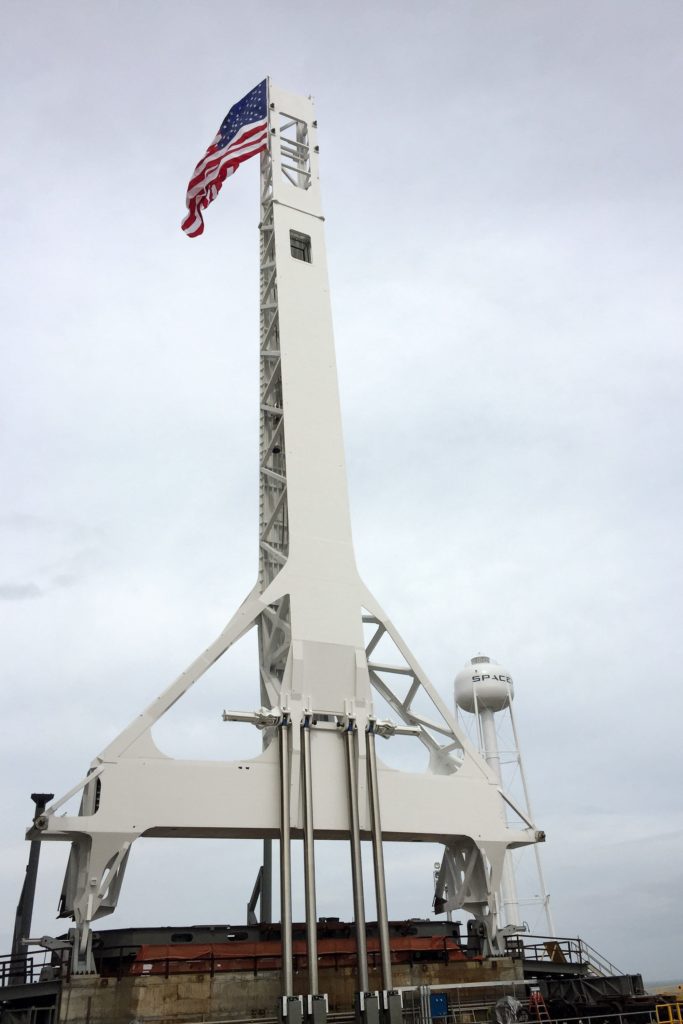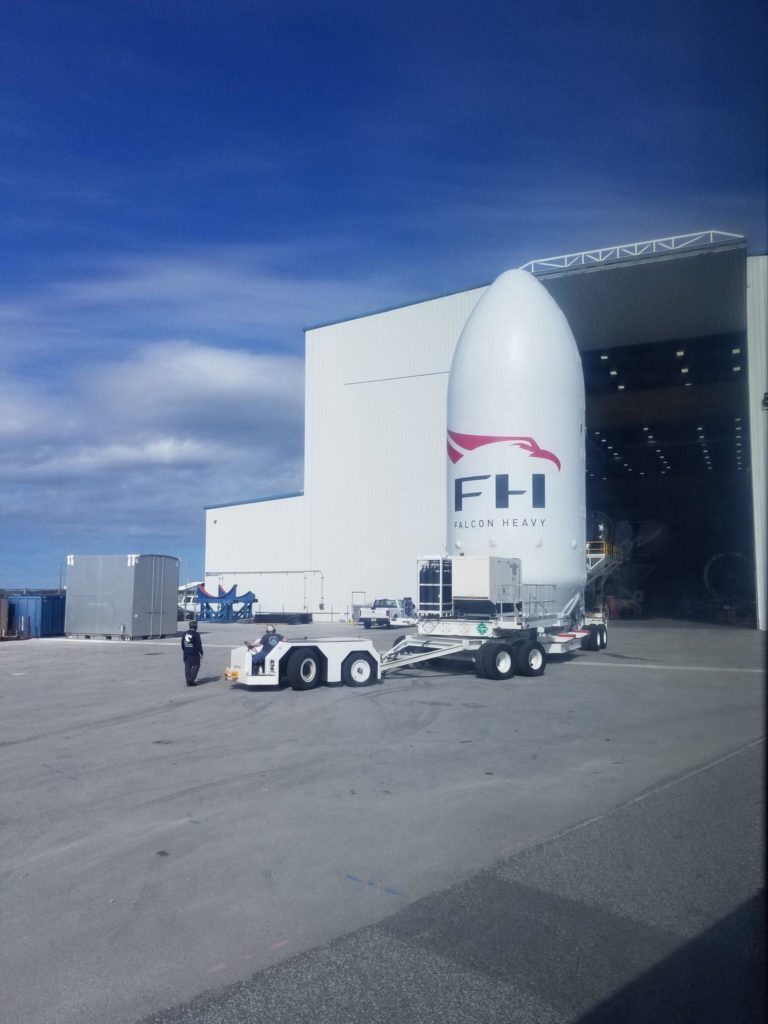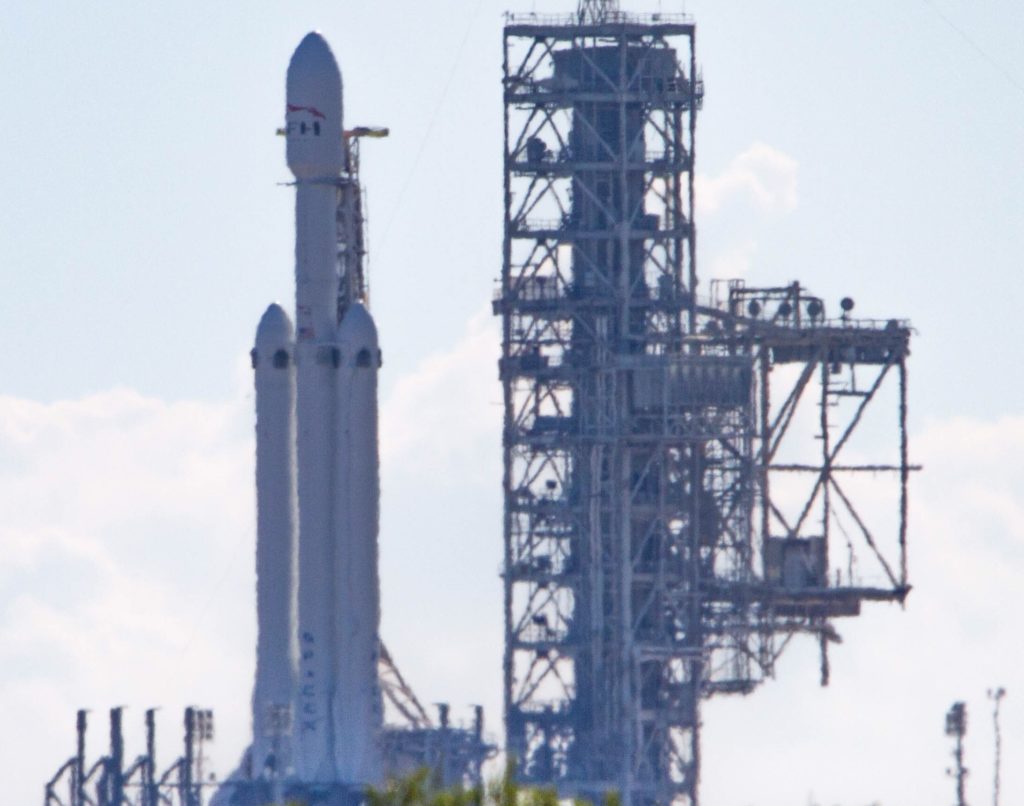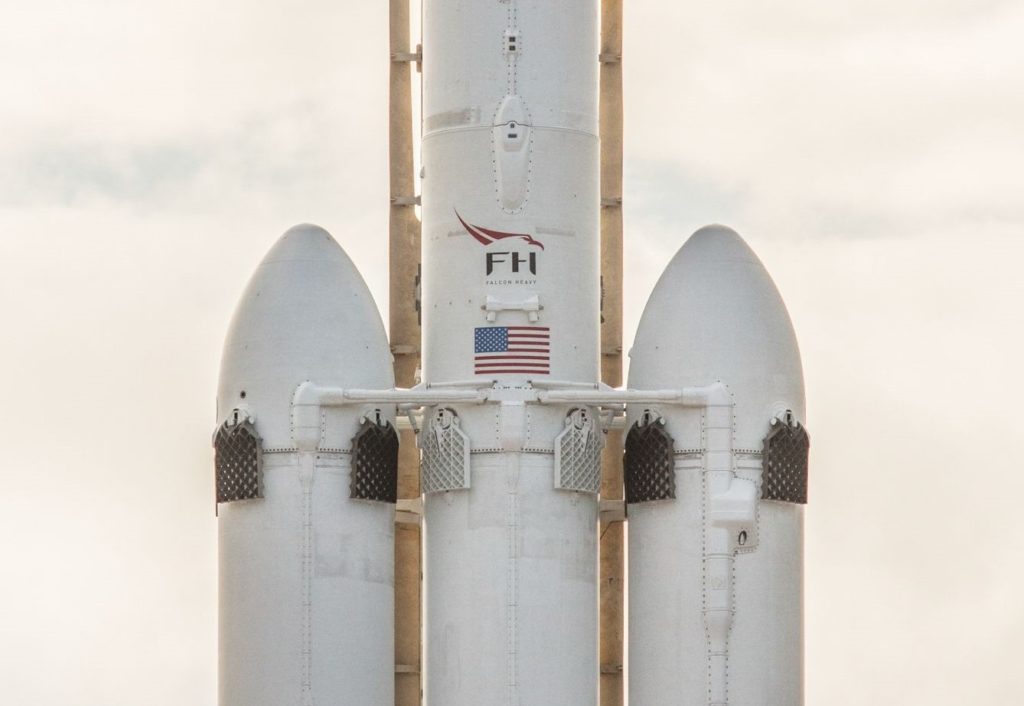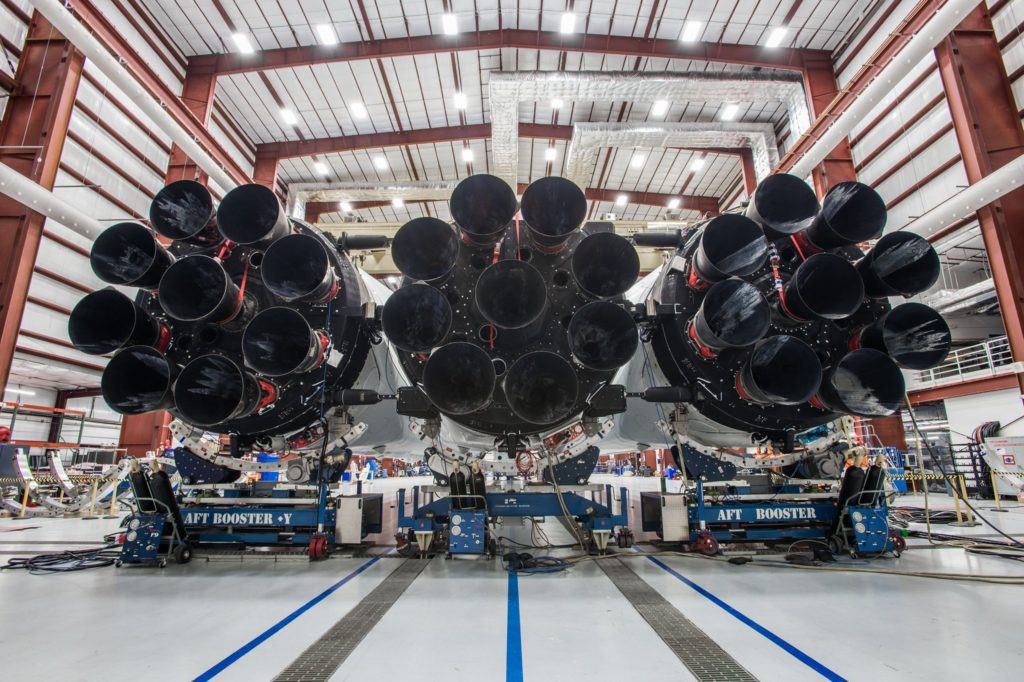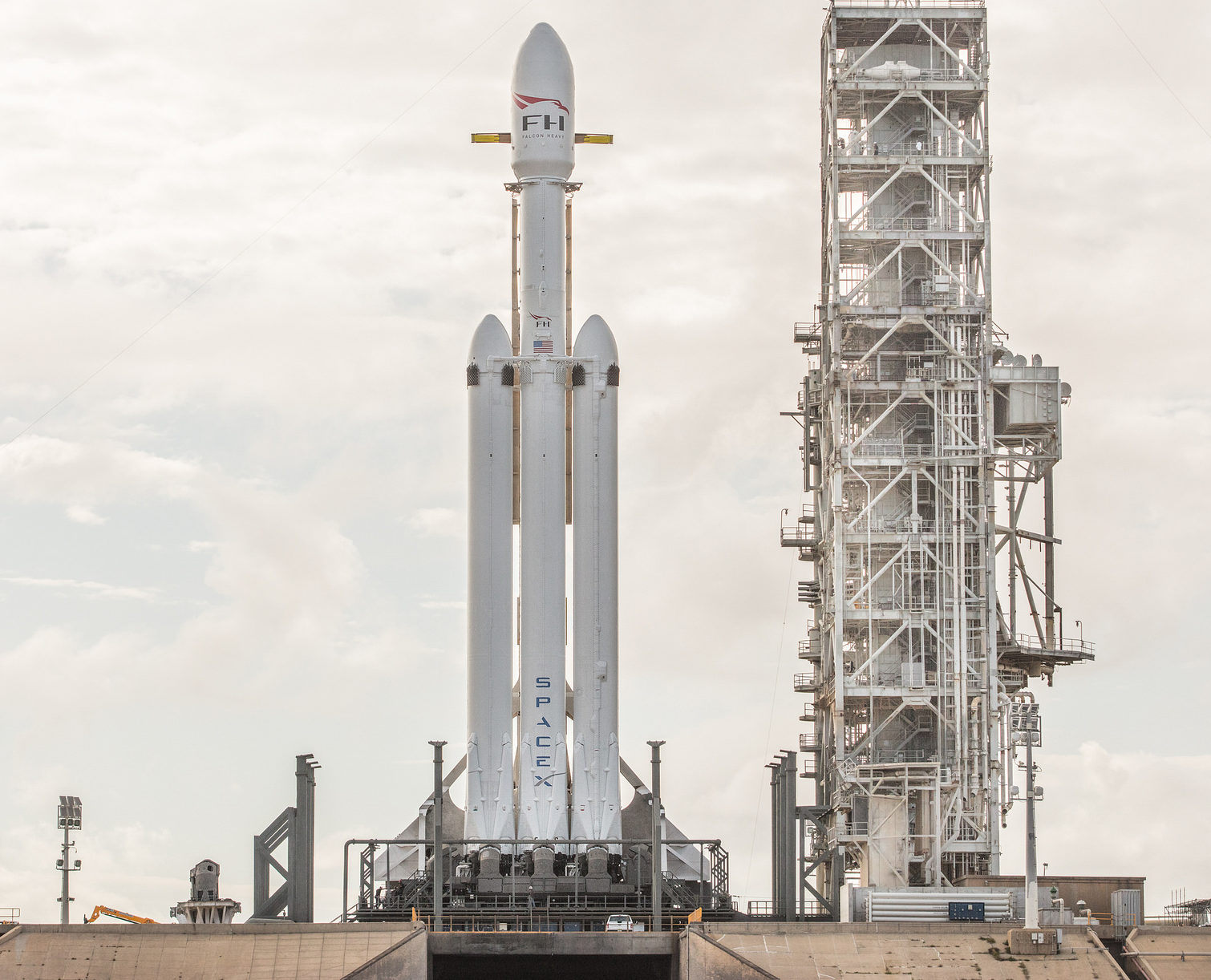

News
SpaceX gets ready to fire up Falcon Heavy for the first time at Cape Canaveral
As it gradually nears a launch date sometime in late January or early February, SpaceX’s new super-heavy launch vehicle (SHLV) Falcon Heavy has weathered a number of schedule delays in preparation for a historic and crucial moment – its first static fire/test ignition that’s currently scheduled for Tuesday, January 16, beginning at 4pm EST (2100 GMT).
Those focused on the gritty details of SpaceX’s prelaunch procedures will have immediately noted how different Falcon Heavy’s operations are when compared with SpaceX’s workhorse rocket and Heavy’s progenitor, Falcon 9. For a typical launch of Falcon 9, the rocket and payload will normally arrive at the given launch pad around a month or so before the anticipated launch date. Next, the satellite payload is encapsulated inside Falcon 9’s payload fairing, typically two or so weeks before launch. Pad facilities would be thoroughly examined after the previous launch to remedy any wear and tear and ensure that it is in good working order ahead of the next mission. Approximately a week before launch, Falcon 9’s first and second stages are mated together inside the pad’s integration facilities, the pad’s Transport/Erector/Launcher (TEL) is rolled into the integration facilities, and the Falcon 9 booster and second stage (sans payload) are mounted onto the TEL. Finally, the TEL and rocket are rolled out to the launch pad for a brief 3-5 second static fire around 5-7 days before launch. After testing is completed, the TEL is rolled back to the integration facilities, the payload fairing and payload are attached to the rocket, and the whole stack is once more rolled back to the pad, ready for launch.
- The TEL seen at LC-39A in early 2017. (SpaceX)
- The base of the TEL now sports multiple additional launch clamps (large grey protrusions) that will be needed for Falcon Heavy’s three first stage cores. (SpaceX)
- Finally, the fairing is transported vertically to the HIF, where it can be flipped horizontal and attached to its rocket. (Reddit /u/St-Jed-of-Calumet)
For a used booster, this is the sum total of the prelaunch procedures it will go through at the pad, after recovery and refurbishment. For all new boosters, however, SpaceX currently conducts a thorough slate of tests for all Merlin 1D and MVac (2nd stage) rocket engines, as well as both the integrated first and second stages at its McGregor, Texas facilities. These tests last far longer than those conducted at the launch pad, and typically run for the full length of a launch in order to better simulate the stresses flight hardware will end up experiencing. In other words, new Falcon 9 hardware always has to make it through hundreds of seconds of live firing and post-test analysis before finally being shipped to SpaceX’s launch facilities, where it conducts the aforementioned brief static fire at the pad.
A whole new bird of prey
To put it simply, Falcon Heavy is a whole different animal when it comes to prelaunch testing. Due to the rocket’s sheer size and power in its fully integrated state, McGregor simply does not have the capability to conduct the same tests it does with Falcon 9. While two of the first Heavy’s three first stage boosters are modified flight-proven Falcon 9s (from Thaicom-8 and CRS-9), the center core required a far more extensive suite of changes from a normal Falcon 9 in order to survive the added stresses it would experience during a Falcon Heavy launch. Although the full-up vehicle could not be tested in Texas with a full-length firing, each of its three first stages and upper stage went through the same tests as a normal Falcon 9. Before that, both side core and center core structural test articles (STA) went through a large amount of mechanical stress testing to verify that Falcon Heavy’s re-engineered design would be able to easily survive the stresses of launch and then some. In short, months and months of work have gone into the hardware that both preceded and makes up the Falcon Heavy rocket currently vertical and weeks from launch at Kennedy Space Center.
However, SpaceX has learned the hard way that simulation and partial physical testing can only go so far, and cannot be completely trusted when it comes to flying new hardware, as evidenced by the both Falcon 1 and the company’s several first attempts at recovering a Falcon 9 booster (intact, at least…). Even the best and most brilliant engineers and technicians can only do so much without testing the real thing in real conditions, something that can often result in unintended failures – especially the case with new technologies. Falcon Heavy is indeed a new technology to some extent or at least incorporates numerous new technologies that SpaceX has little to no operational experience with. These and relatively untried aspects include the simultaneous ignition and operation of twenty seven already powerful Merlin 1D engines, new stresses on the center booster during launch, a unique non-explosive side booster separation mechanism, the also near-simultaneous recovery of three first stages, and a second stage tasked with placing an unusual payload in the highest orbit SpaceX has yet to attempt.
Hence Elon Musk’s aggressive expectation maintenance over the last year or so, in which he spared no punches while imparting upon several audiences the likelihood that Falcon Heavy’s first launch would fail entirely, and maybe even destroy the launch pad. In reality, SpaceX is clearly doing everything in their power to ensure that the massive rocket’s first launch is a total success.
- Falcon Heavy vertical at Pad 39A on Thursday, January 11. After a successful rehearsal, the static fire was scrubbed due to a small hardware bug. (Tom Cross/Teslarati)
- The white bars in this photo are half of Falcon Heavy’s seperation mechanism. A number of actuators take the place of the more common solid rocket motors used with vehicles like the Delta IV Heavy. (SpaceX)
- Falcon Heavy’s three boosters and 27 Merlin 1D engines on full display. (SpaceX)
What’s next for Falcon Heavy?
Recent delays to the vehicle’s first static fire test at SpaceX’s Launch Complex 39A are strong examples of this cautious approach. While fans and outsiders alike may be nipping at the bit for the vehicle’s long-awaited inaugural static fire and launch, SpaceX clearly is laser-focused on very thoroughly testing the vehicle and is exerting great caution. After the first static fire attempt was delayed, reportedly due to a buggy launch clamp, SpaceX had nevertheless completed its first (presumably successful) wet dress rehearsal (WDR), which saw the vehicle prepared for launch with a full load of propellant and other miscellaneous fluids. After a brief period back horizontal at the pad, likely to repair whatever fault initially caused the delay, Falcon Heavy has been vertical at the pad for the last several days. Intriguingly, albeit unsurprisingly, tank venting was reported early Sunday by local observers. This indicates that SpaceX conducted at least one additional wet dress rehearsal with Falcon Heavy, likely both contributing to an additional delay of the replacement static fire date (Monday) and solidifying confidence in the new test date, Tuesday, January 16.
Compared with the results of the first WDR (a three-day delay), the one day delay that followed Sunday’s rehearsal is great news for what is effectively a mature launch vehicle prototype. SpaceX’s confidence is clearly growing, and while all delays of the static fire will likely push back the launch date at least as much, Falcon Heavy will almost certainly find itself days away from its inaugural liftoff sometime in very late January or February 2018.
Follow along live as Teslarati’s launch photographer Tom Cross covers Falcon Heavy’s exciting series of events while they happen on our Instagram.
Elon Musk
Tesla Supercharger Diner food menu gets a sneak peek as construction closes out
What are you ordering at the Tesla Diner?

The Tesla Supercharger Diner in Los Angeles is nearing completion as construction appears to be winding down significantly. However, the more minor details, such as what the company will serve at its 50s-style diner for food, are starting to be revealed.
Tesla’s Supercharger Diner is set to open soon, seven years after CEO Elon Musk first drafted the idea in a post on X in 2018. Musk has largely come through on most of what he envisioned for the project: the diner, the massive movie screens, and the intended vibe are all present, thanks to the aerial and ground footage shared on social media.
We already know the Diner will be open 24/7, based on decals placed on the front door of the restaurant that were shared earlier this week. We assume that Tesla Optimus will come into play for these long and uninterrupted hours.
The Tesla Diner is basically finished—here’s what it looks like
As far as the food, Tesla does have an email also printed on the front door of the Diner, but we did not receive any response back (yet) about what cuisine it will be offering. We figured it would be nothing fancy and it would be typical diner staples: burgers, fries, wings, milkshakes, etc.
According to pictures taken by @Tesla_lighting_, which were shared by Not a Tesla App, the food will be just that: quick and affordable meals that diners do well. It’s nothing crazy, just typical staples you’d find at any diner, just with a Tesla twist:
Tesla Diner food:
• Burgers
• Fries
• Chicken Wings
• Hot Dogs
• Hand-spun milkshakes
• And more https://t.co/kzFf20YZQq pic.twitter.com/aRv02TzouY— Sawyer Merritt (@SawyerMerritt) July 17, 2025
As the food menu is finalized, we will be sure to share any details Tesla provides, including a full list of what will be served and its prices.
Additionally, the entire property appears to be nearing its final construction stages, and it seems it may even be nearing completion. The movie screens are already up and showing videos of things like SpaceX launches.
There are many cars already using the Superchargers at the restaurant, and employees inside the facility look to be putting the finishing touches on the interior.
🚨 Boots on the ground at the Tesla Diner:
— TESLARATI (@Teslarati) July 17, 2025
It’s almost reminiscent of a Tesla version of a Buc-ee’s, a southern staple convenience store that offers much more than a traditional gas station. Of course, Tesla’s version is futuristic and more catered to the company’s image, but the idea is the same.
It’s a one-stop shop for anything you’d need to recharge as a Tesla owner. Los Angeles building permits have not yet revealed the date for the restaurant’s initial operation, but Tesla may have its eye on a target date that will likely be announced during next week’s Earnings Call.
News
Tesla’s longer Model Y did not scale back requests for this vehicle type from fans
Tesla fans are happy with the new Model Y, but they’re still vocal about the need for something else.

Tesla launched a slightly longer version of the Model Y all-electric crossover in China, and with it being extremely likely that the vehicle will make its way to other markets, including the United States, fans are still looking for something more.
The new Model Y L in China boasts a slightly larger wheelbase than its original version, giving slightly more interior room with a sixth seat, thanks to a third row.
Tesla exec hints at useful and potentially killer Model Y L feature
Tesla has said throughout the past year that it would focus on developing its affordable, compact models, which were set to begin production in the first half of the year. The company has not indicated whether it met that timeline or not, but many are hoping to see unveilings of those designs potentially during the Q3 earnings call.
However, the modifications to the Model Y, which have not yet been officially announced for any markets outside of China, still don’t seem to be what owners and fans are looking forward to. Instead, they are hoping for something larger.
A few months ago, I reported on the overall consensus within the Tesla community that the company needs a full-size SUV, minivan, or even a cargo van that would be ideal for camping or business use.
Tesla is missing one type of vehicle in its lineup and fans want it fast
That mentality still seems very present amongst fans and owners, who state that a full-size SUV with enough seating for a larger family, more capability in terms of cargo space for camping or business operation, and something to compete with gas cars like the Chevrolet Tahoe, Ford Expedition, or electric ones like the Volkswagen ID.BUZZ.
We asked the question on X, and Tesla fans were nearly unanimously in support of a larger SUV or minivan-type vehicle for the company’s lineup:
🚨 More and more people are *still* saying that, despite this new, longer Model Y, Tesla still needs a true three-row SUV
Do you agree? https://t.co/QmbRDcCE08 pic.twitter.com/p6m5zB4sDZ
— TESLARATI (@Teslarati) July 16, 2025
Here’s what some of the respondents said:
100% agree, we need a larger vehicle.
Our model Y is quickly getting too small for our family of 5 as the kids grow. A slightly longer Y with an extra seat is nice but it’s not enough if you’re looking to take it on road trips/vacations/ kids sports gear etc.
Unfortunately we…
— Anthony Hunter (@_LiarsDice_) July 17, 2025
Had to buy a Kia Carnival Hybrid because Tesla doesn’t have a true 3 row vehicle with proper space and respectable range. pic.twitter.com/pzwFyHU8Gi
— Neil, like the astronaut (@Neileeyo) July 17, 2025
Agreed! I’m not sure who created this but I liked it enough to save it. pic.twitter.com/Sof5nMehjS
— 🦉Wise Words of Wisdom – Inspirational Quotes (IQ) (@WiseWordsIQ) July 16, 2025
Tesla is certainly aware that many of its owners would like the company to develop something larger that competes with the large SUVs on the market.
However, it has not stated that anything like that is in the current plans for future vehicles, as it has made a concerted effort to develop Robotaxi alongside the affordable, compact models that it claims are in development.
It has already unveiled the Robovan, a people-mover that can seat up to 20 passengers in a lounge-like interior.
The Robovan will be completely driverless, so it’s unlikely we will see it before the release of a fully autonomous Full Self-Driving suite from Tesla.
Energy
Tesla launches first Virtual Power Plant in UK – get paid to use solar
Tesla has launched its first-ever Virtual Power Plant program in the United Kingdom.

Tesla has launched its first-ever Virtual Power Plant program in the United Kingdom. This feature enables users of solar panels and energy storage systems to sell their excess energy back to the grid.
Tesla is utilizing Octopus Energy, a British renewable energy company that operates in multiple markets, including the UK, France, Germany, Italy, Spain, Australia, Japan, New Zealand, and the United States, as the provider for the VPP launch in the region.
The company states that those who enroll in the program can earn up to £300 per month.
Tesla has operated several VPP programs worldwide, most notably in California, Texas, Connecticut, and the U.S. territory of Puerto Rico. This is not the first time Tesla has operated a VPP outside the United States, as there are programs in Australia, Japan, and New Zealand.
This is its first in the UK:
Our first VPP in the UK
You can get paid to share your energy – store excess energy in your Powerwall & sell it back to the grid
You’re making £££ and the community is powered by clean energy
Win-win pic.twitter.com/evhMtJpgy1
— Tesla UK (@tesla_uk) July 17, 2025
Tesla is not the only company that is working with Octopus Energy in the UK for the VPP, as it joins SolarEdge, GivEnergy, and Enphase as other companies that utilize the Octopus platform for their project operations.
It has been six years since Tesla launched its first VPP, as it started its first in Australia back in 2019. In 2024, Tesla paid out over $10 million to those participating in the program.
Participating in the VPP program that Tesla offers not only provides enrolled individuals with the opportunity to earn money, but it also contributes to grid stabilization by supporting local energy grids.
-

 Elon Musk1 day ago
Elon Musk1 day agoWaymo responds to Tesla’s Robotaxi expansion in Austin with bold statement
-

 News1 day ago
News1 day agoTesla exec hints at useful and potentially killer Model Y L feature
-

 Elon Musk2 days ago
Elon Musk2 days agoElon Musk reveals SpaceX’s target for Starship’s 10th launch
-

 Elon Musk3 days ago
Elon Musk3 days agoTesla ups Robotaxi fare price to another comical figure with service area expansion
-

 News1 day ago
News1 day agoTesla’s longer Model Y did not scale back requests for this vehicle type from fans
-

 News1 day ago
News1 day ago“Worthy of respect:” Six-seat Model Y L acknowledged by Tesla China’s biggest rivals
-

 News2 days ago
News2 days agoFirst glimpse of Tesla Model Y with six seats and extended wheelbase
-

 Elon Musk2 days ago
Elon Musk2 days agoElon Musk confirms Tesla is already rolling out a new feature for in-car Grok

